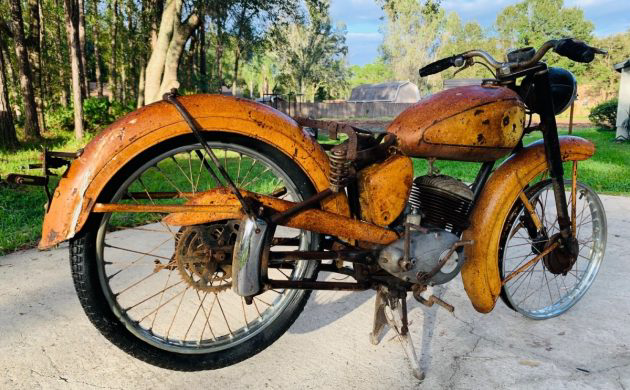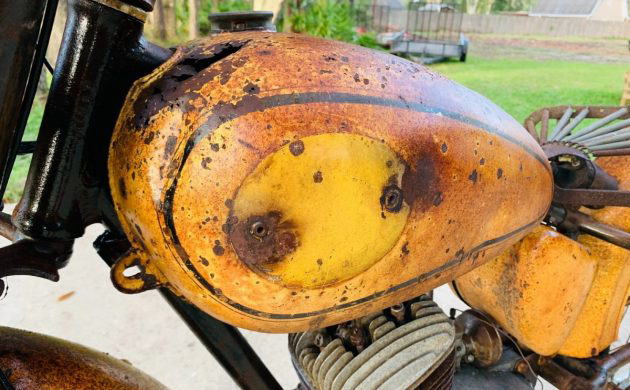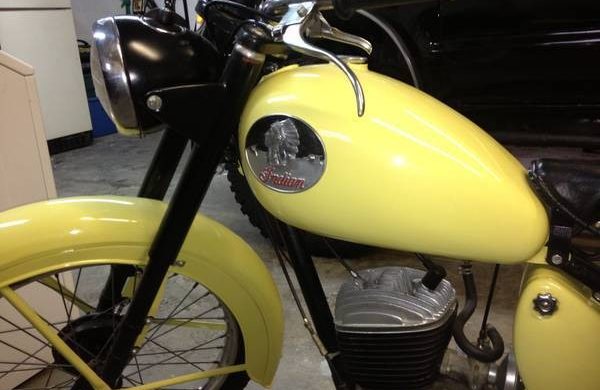Boneyard Find? Rare 1958 Indian Lance Mark II
There’s a weird and wonderful history of the “Indian” motorcycle including how that venerable brand intertwines with one of the true heroes of WWII, the “Flying Flea.” Huh? More on that below–our subject machine above retains its original Sahara Yellow paint (though now righteously patinaed) and is allegedly one of only 274 (yes, fewer than 300) 1955-59 Royal Enfield-built Indian Lance Mark II motorcycles imported to the US. It’s now listed for sale on eBay here with only ONE DAY left in its listing, a current bid of only $405.
Hendee Manufacturing Company opened its factory in Springfield, Mass around 1901, George Hendee soon adding Oscar Hedstrom as a partner in making and selling motorcycles. They eventually renamed the company “Indian Motocycle (correctly spelled, no”r”) Manufacturing Company” in 1923. Their powerful machines were well accepted as civilian and law enforcement bikes. Popular models manufactured by Indian were the Scout (1,000 to 1,133 ccs, made from 1920 to 1946) and the Chief (1,811 ccs, made from 1922 to 1953). Indian developed a business relationship after WWII with Brockhorst Engineering of Great Britain, selling models both in Europe and in trying to expand sales in the U.S. Things just didn’t work out; John Brockhorst was brought in to try and salvage the Post-War poor performance of the brand. In 1950, under Brockhorst’s leadership, Indian brought a 247 cc Indian Brave Model to market on both sides of the pond. After valiant efforts with several other models (including one named “Papoose”), Indian Motocycle’s Springfield plant finally closed for good in 1953. As part of the liquidation process, Brockhorst wound up with the future rights to the Indian brand. Our subject machine, branded as an Indian, came out in the U.S. two years later having a 148 cc single-piston two-stroke engine pushing six hp through its three-speed gearbox and weighing just 183 pounds. It was capable of a screeching 4,750 RPMs. Seller of the subject Mark II has revealed that the engine is frozen unfortunately.
And the gas tank is pretty rough, with pitting and rotting occurring near the gas cap and the front fork area. This gas cap reads “Two measures OIL to ONE GALLON of petrol.” Several brands of oil are listed on the gas cap for two-stroke lubrication, that cap bearing a striking resemblance to a U.S. Geographical Survey marker. Incidentally, the 50 photos accompanying the eBay write up are beautifully taken and clear. The light was perfect the day they were shot in Lutz, Florida where the Mark II is resting currently.
This photo shows the serious rot along the top of the gas tank and reveals a more material and pertinent issue: the chrome badges that should be found on both sides of the tank are missing. Oh-oh. With such a limited number of bikes made, are replacement parts non-existent? Where, for example, would NOS chrome emblems or a new gas tank be found? There may not be enough demand for re-manufactured parts. Replacement parts, then, are likely going to be handmade originals especially for the tank (really pricey-pricey) and the badges (also pricey-pricey) and probably most everything else. The buyer of this bike will need a 3-d printer, a metal lathe, a few engineers, imagination and both of Mom’s credit cards.
This example shows the vivid, deep relief of the Indian in full headdress on the stamped logo badge (seen here on a completely restored Lance Mark II). There are other easily seen distinctive components that may cause trouble for the restorer: one is a big chip on one of the left side jug splines, and then this:
. . .the speedo, odometer and switch area of the headlight bezel are seriously corroded and pitted. Hmm. While you’re thinking about sourcing spare parts–how, then, is this Indian Lance Mark II and the WWII hero, the “Flying Flea,” related? During the war, the Enfield Cycle Company in Worcestershire produced multiple Royal Enfield brand motorcycles for the British war effort. One particularly special motorcycle, a 125 cc two-stroke model dubbed the WD/RE was made for a variety of troops-on-the-ground requirements like reconnaissance, secret non-radio communications, troop transport, rescues, medical deliveries and the like. Enfield engineered the motorcycles and, after several failed efforts, finally developed a tubular crate where the cycle was able to be dropped to the ground by airplane or glider in one piece, bouncing like a flea on impact. Laugh as you may, more than 600 “Flying Fleas” were used on D-Day by the Third Infantry Division to help coordinate beach landings. We are collectively forever grateful for how that effort turned out. Below is a bit of war time news proudly discussing the Royal Enfield contribution to the war effort:
You can read more interesting facts about the Royal Enfield’s “Flying Fleas” here. Now when Brockhorst acquired the rights to the Indian brand through bankruptcy in 1953, Enfield teamed up with him to market a similar bike to the Flying Flea in the United States under the Indian brand, those just like our subject motorcycle. There’s the union between the Indian brand and the Flying Flea. Not sure why, but Americans did not connect with the little two-stroke, and the “badge engineering” effort of the Enfield-Indian bike really bombed. The decision to pull the plug on manufacturing was made in 1958; some remaining parts made up the final 1959 models sold, and in 1960 the joint sales venture mercifully expired.
One last shot of our subject Indian cycle, representing its renowned motorcycle brand. From the roaring Indian V-Twin machines of the 30s and 40s to nearly the last gasp of the brand with the two-stroke cousin of the “Flying Flea,” the recent reinvigoration of the brand and its muscular big machines has shown “Indian” to be a revered survivor despite the stumbles. Please catch this Indian Lance Mark II listing on eBay until WEDNESDAY night–Seller does have some interesting documentation on this machine including the original sales invoice and financing note. (No, really–someone took out a $270 loan on this bike May 12, 1958!).
Auctions Ending Soon
 1969 Ford MustangBid Now17 hours$1,050
1969 Ford MustangBid Now17 hours$1,050
 1965 Ford Falcon Station WagonBid Now3 days$2,300
1965 Ford Falcon Station WagonBid Now3 days$2,300
 2002 Jaguar XK8 ConvertibleBid Now4 days$4,250
2002 Jaguar XK8 ConvertibleBid Now4 days$4,250
 1979 Chevrolet Camaro Z/28Bid Now5 days$4,500
1979 Chevrolet Camaro Z/28Bid Now5 days$4,500
 1960 Dodge D300Bid Now5 days$300
1960 Dodge D300Bid Now5 days$300









Comments
I nearly bought a Royal Enfield “Flying Flea” when I was working for a South African auction house. That was until I sat on it and at 6ft 2in felt like a pimple (Zit) on a haystack!
Nice to hear from our friends from UK, Ken.
Don’t have any photos of that Flying Flea encounter, do you?
Second, are there many Flying Fleas left in Europe and do they come up for sale regularly if so?
Curious about opinions toward Royal Enfield bikes in general if you can share.
MT
Hi Mike. I have searched my computer but can’t find any pics of the Flea, however, I will send if I can find them. There are 574 Royal Enfield bikes for sale on Gumtree UK but not one of them is a Flying Flea, so it looks like they are pretty rare machines. As for the Royal Enfield itself, I owned a 1953 RE Bullet 500cc single back in the early eighties and I absolutely loved it. I attached a Kali sidecar to it and my mate swapped it for a Triumph TR 3a while I was on holiday in America. It was a deal that I was negotiating before I left for US because I have a trick ankle from a previous crash on an AJS 600cc Super Sport and found the compression of the Enfield to strong for my foot. My friend had a Constellation at the time and I rode it a few times and found it to be a great bike and if I could have afforded it at the time I would have bought one. If the Indians can’t kill them, what with their roads and the loads that they subject them to, then nobody can kill them.
Royal Enfields always looked neat. I had no idea of the history with Indian, that I also like( but could never afford). Thank you for the history lesson. ( another reason I love BF) It looks like a neat beast. I hope it doesn’t become the parts bike for another one, but whatever it takes I guess.
how can I purchase this?
Robert–go to the eBay hotlink in the article I wrote where it says “on eBay here” and that will take you to the listing.
MJT
This wasn’t Indians first foray into the world of small 2 strokes either. If you google Indian CZ you’ll see what I mean.
You are right. . .they also did the tiny Papoose as well.
Wow, this is a ‘Tireless’ example of biking history.
🥳
I love that, Phil.
Considering changing your nickname from Phlathead Phil to Paronomasia Phil!
Keep ’em comin’
SOLD for $1,975.